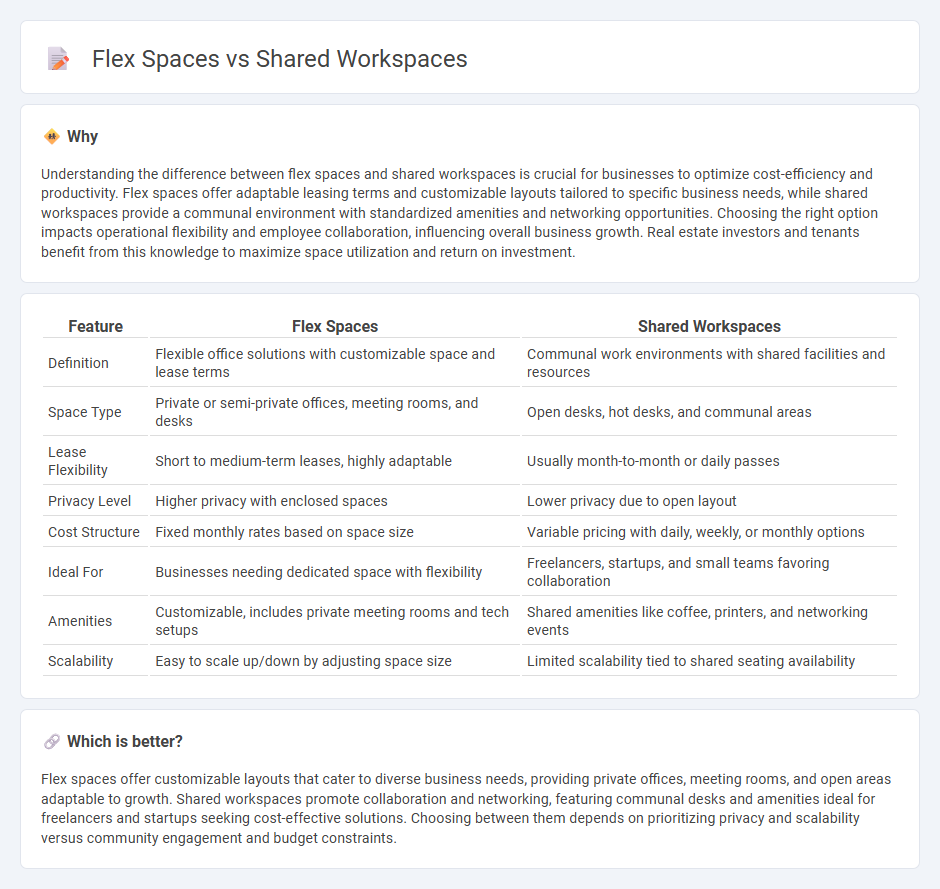
Flex spaces offer adaptable work environments tailored to business needs, providing private offices, meeting rooms, and communal areas with flexible lease terms. Shared workspaces focus on community-driven setups where professionals collaborate and utilize shared amenities, fostering networking and reducing overhead costs. Explore the key differences and benefits to determine the ideal workspace solution for your business.
Why it is important
Understanding the difference between flex spaces and shared workspaces is crucial for businesses to optimize cost-efficiency and productivity. Flex spaces offer adaptable leasing terms and customizable layouts tailored to specific business needs, while shared workspaces provide a communal environment with standardized amenities and networking opportunities. Choosing the right option impacts operational flexibility and employee collaboration, influencing overall business growth. Real estate investors and tenants benefit from this knowledge to maximize space utilization and return on investment.
Comparison Table
| Feature | Flex Spaces | Shared Workspaces |
|---|---|---|
| Definition | Flexible office solutions with customizable space and lease terms | Communal work environments with shared facilities and resources |
| Space Type | Private or semi-private offices, meeting rooms, and desks | Open desks, hot desks, and communal areas |
| Lease Flexibility | Short to medium-term leases, highly adaptable | Usually month-to-month or daily passes |
| Privacy Level | Higher privacy with enclosed spaces | Lower privacy due to open layout |
| Cost Structure | Fixed monthly rates based on space size | Variable pricing with daily, weekly, or monthly options |
| Ideal For | Businesses needing dedicated space with flexibility | Freelancers, startups, and small teams favoring collaboration |
| Amenities | Customizable, includes private meeting rooms and tech setups | Shared amenities like coffee, printers, and networking events |
| Scalability | Easy to scale up/down by adjusting space size | Limited scalability tied to shared seating availability |
Which is better?
Flex spaces offer customizable layouts that cater to diverse business needs, providing private offices, meeting rooms, and open areas adaptable to growth. Shared workspaces promote collaboration and networking, featuring communal desks and amenities ideal for freelancers and startups seeking cost-effective solutions. Choosing between them depends on prioritizing privacy and scalability versus community engagement and budget constraints.
Connection
Flex spaces and shared workspaces are integral components of the evolving real estate landscape, offering adaptable office environments that cater to dynamic business needs. These spaces maximize square footage efficiency through multi-use designs, attracting startups, freelancers, and corporations seeking cost-effective, collaborative settings. Emphasizing location flexibility and scalable leases, flex and shared workspaces drive demand in commercial real estate markets by responding to trends in remote work and hybrid office models.
Key Terms
Lease Structure
Shared workspaces typically operate on short-term, flexible lease agreements that allow businesses to rent desks or offices with minimal commitment, promoting scalability and cost-efficiency. Flex spaces often offer a hybrid lease structure, combining traditional long-term leases with the option for flexible, short-term use, catering to companies seeking adaptability without sacrificing stability. Explore the differences in lease structures further to determine which workspace model best suits your business needs.
Space Utilization
Shared workspaces optimize space utilization by allowing multiple users or businesses to share common areas, reducing the need for dedicated office space and maximizing occupancy rates. Flex spaces offer adaptability through modular layouts and scalable options, enabling companies to adjust their footprint according to fluctuating needs and enhance operational efficiency. Discover how tailored space solutions can transform your workplace strategy by exploring key differences in space utilization.
Membership Model
Shared workspaces typically offer fixed membership models with dedicated desks or offices, providing a stable environment for teams and individual professionals. Flex spaces emphasize flexible membership options, allowing users to access various work areas and services on-demand, catering to dynamic schedules and varying workspace needs. Explore the differences in membership models to find the ideal workspace solution for your business growth.
Source and External Links
Regus Coworking - Rent flexible, fully-serviced desks or offices in a global network of vibrant coworking spaces designed for collaboration and convenience.
Coworker - Search and reserve shared workspaces, private offices, and meeting rooms worldwide, comparing amenities to find the best fit for your needs.
Nomadworks - Join a wellness-focused, community-driven coworking network in NYC with premium amenities and global access to partner spaces.
 dowidth.com
dowidth.com